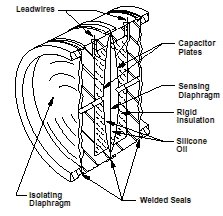The measurement of pressure is considered the basic process variable in that it is utilized for measurement of flow (difference of two pressures), level (head or back pressure), and even temperature (fluid pressure in a filled thermal system).
All pressure measurement systems consist of two basic parts: a primary element, which is in contact, directly or indirectly, with the pressure medium and interacts with pressure changes; and a secondary element, which translates this interaction into appropriate values for use in indicating, recording and/or controlling.
An electronic-type transmitter is shown in the figure above. This particular type utilizes a two-wire capacitance technique.

Process pressure is transmitted through isolating diaphragms and silicone oil fill fluid to a sensing diaphragm in the center of the cell. The sensing diaphragm is a stretched spring element that deflects in response to differential pressure across it.
The displacement of the sensing diaphragm is proportional to the differential pressure. The position of the sensing diaphragm is detected by capacitor plates on both sides of the sensing diaphragm. The differential capacitance between the sensing diaphragm and the capacitor plates is converted electronically to a 4-20 mA dc signal.